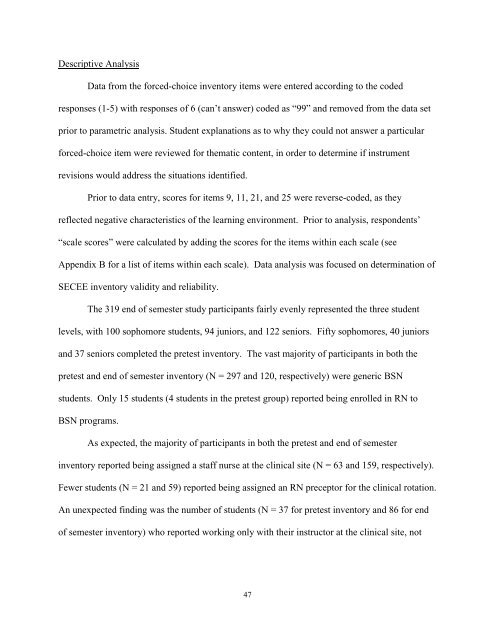STUDENT EVALUATION OF CLINICAL EDUCATION ENVIRONMENT
STUDENT EVALUATION OF CLINICAL EDUCATION ENVIRONMENT
STUDENT EVALUATION OF CLINICAL EDUCATION ENVIRONMENT
Create successful ePaper yourself
Turn your PDF publications into a flip-book with our unique Google optimized e-Paper software.
Descriptive Analysis<br />
Data from the forced-choice inventory items were entered according to the coded<br />
responses (1-5) with responses of 6 (can’t answer) coded as “99” and removed from the data set<br />
prior to parametric analysis. Student explanations as to why they could not answer a particular<br />
forced-choice item were reviewed for thematic content, in order to determine if instrument<br />
revisions would address the situations identified.<br />
Prior to data entry, scores for items 9, 11, 21, and 25 were reverse-coded, as they<br />
reflected negative characteristics of the learning environment. Prior to analysis, respondents’<br />
“scale scores” were calculated by adding the scores for the items within each scale (see<br />
Appendix B for a list of items within each scale). Data analysis was focused on determination of<br />
SECEE inventory validity and reliability.<br />
The 319 end of semester study participants fairly evenly represented the three student<br />
levels, with 100 sophomore students, 94 juniors, and 122 seniors. Fifty sophomores, 40 juniors<br />
and 37 seniors completed the pretest inventory. The vast majority of participants in both the<br />
pretest and end of semester inventory (N = 297 and 120, respectively) were generic BSN<br />
students. Only 15 students (4 students in the pretest group) reported being enrolled in RN to<br />
BSN programs.<br />
As expected, the majority of participants in both the pretest and end of semester<br />
inventory reported being assigned a staff nurse at the clinical site (N = 63 and 159, respectively).<br />
Fewer students (N = 21 and 59) reported being assigned an RN preceptor for the clinical rotation.<br />
An unexpected finding was the number of students (N = 37 for pretest inventory and 86 for end<br />
of semester inventory) who reported working only with their instructor at the clinical site, not<br />
47












